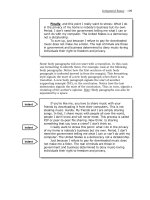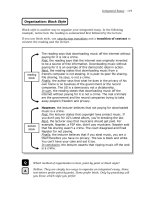- Trang chủ >>
- Khoa Học Tự Nhiên >>
- Vật lý
Green Energy and Technology - Energy for a Warming World Part 9 doc
Bạn đang xem bản rút gọn của tài liệu. Xem và tải ngay bản đầy đủ của tài liệu tại đây (259.53 KB, 19 trang )
144 5 Known Knowns and the Unknown
expenditure in the region of 4% of the global economy is called for. It should be
noted that this money does not disappear, like investments in modern banks are
prone to do, it gets spent on real physical infrastructure. It represents a good old
Keynesian boost to the world economy.
5.4 The Unknowable
From the miniscule scale of nano-engineering, where molecules are massaged to
form novel materials, to electrical engineering on the macroscopic scale where
massive components are manipulated to build power stations and other large elec-
trical systems, in general the technical problems that are encountered by scien-
tists/engineers, have known or knowable solutions. Because of this most technolo-
gists would probably aver that engineering in the physical world is largely ‘child’s
play’, by comparison with the complexities and imponderables inherent in the
social version, where problems seemingly have no definitive answer, or the an-
swers are politically unpalatable, or they have a myriad of answers all of which
generate further problems! Unknown knowns or perhaps known unknowns? Who
knows? The social engineering of reluctant and recalcitrant mankind, away from
its drug-like dependency on fossil fuels, which is absolutely essential to a success-
ful transition to renewable energy, seems a daunting task, if just democratic and
market levers are employed. On all the available evidence, it will call for voter and
consumer manipulation of a truly Machiavellian quality and scale to shift en-
trenched attitudes in the market fixated democracies. It is difficult to be confident
that this will ever happen. What is really needed is wise leadership. But politicians
who are sufficiently knowledgeable to be wise seem no longer to exist.
Returning to the world of do-able engineering, an effective ecogrid, as we have
now seen, can be built, but it will be necessary to divert a considerable proportion
of the globe’s human resources and capital towards implementing this task. The
question that then arises is to what extent, and in what way, this huge undertaking
will impinge on the rest of the global economy? To answer this kind of broad
economic question it is usual to resort to a sophisticated computer model of the
economy, but even with the best of these it is prudent to exercise a suitable degree
of caution in applying or interpreting the results, because:
a model is a simplified representation of reality. If it were a perfect replica, it would not
be useful. For example, a road map would be of no use to drivers if it contained every fea-
ture of the landscape it represents – it focuses on roads and omits, for example, most fea-
tures of buildings and plants along the way. [29]
At the level of global economics and population dynamics one such model is
WORLD3, which is described in detail in ‘Limits to Growth’ (LTG) [29]. This
simulation is a complex, non-linear, delayed-response computer program, which
keeps track of stocks such as population, industrial capital, persistent pollution,
5.4 The Unknowable 145
and cultivated land. It calculates the movements of major parameters such as
population (through births and deaths), capital stock (through investment and
depreciation), arable land (through erosion, pollution, urban and industrial sprawl)
and non-renewable resources. All of these parameters and others are linked
through multiple nested feedback and feedforward loops. The primary global out-
puts from the program are presented in three categories, namely: ‘state of the
world’, ‘material standard of living’, and ‘human welfare’, as a function of time.
The first category includes available resources, food production, industrial output,
population level and pollution level. Material standard of living includes life ex-
pectancy, food/person, consumer goods/person and services/person, while human
welfare presents us with the changes over time in the model ‘world’ in a human
welfare index and in the human ecological footprint.
One of the computer runs described in LTG, directs the WORLD3 model of the
global economy to simulate a scenario in which a massive enforcement of pollu-
tion reduction is introduced into the model economy. In a ‘world’, which in 2000
has plentiful non-renewable resources, and in which human beings have developed
sophisticated technology to extract these resources, the assumption is made that
mankind decides to make a concerted effort to tackle pollution by diverting 4%
per year (about $
2
trillion in 2000) of global output into technology to eradicate it,
this effort commencing in 2002. This scenario is not unlike one in which humans
might consider diverting 4%/year of global capital into building an ecogrid. The
convergence of the two figures is obviously helpful, but it is entirely fortuitous.
The simulation predicts that pollution will continue to rise for nearly 50 years
after 2000 despite the drive towards renewables. This is because of delays in im-
plementation and because of continuing industrial and population growth. But, as
one would hope and expect, the pollution level is predicted to drop to a considera-
bly lower level from 2030 until 2100, than it would have done in a ‘world’ where
the transition were not attempted (BAU scenario). Pollution never gets high
enough to deleteriously affect human health and consequently the transition to
renewables succeeds in prolonging the delivery of high welfare to a high popula-
tion for another generation. But that is it! In the model ‘world’ the ‘good times’
come to an end in about 2080, just forty more years further into the future than in
the BAU scenario. Population pressure and demand for consumer goods causes
a continuing rapid growth in industrial output, soaking up mineral and other re-
sources, so that by 2070 the costs of extraction become so overwhelming to the
rest of the economy that collapse occurs. Also, although pollution is lower than in
the BAU scenario, it is still enough to have a negative affect on land fertility, and
eventually food production cannot match demand from the growing population.
Human welfare collapses by about 2080.
The sad fact is that, in the model ‘world’ of LTG, of the many scenarios, that
are postulated and dissected in order to assess possible futures for a resource lim-
ited planet, all predict eventual collapse for the global economy. No matter what
we do, the end of the ‘good times’ comes before 2100, unless global over-popula-
tion is seriously addressed. Of course, this is a model prediction, which is no better
that the data supplied to it. It should therefore be interpreted with caution. How-
146 5 Known Knowns and the Unknown
ever, as far as one can gauge, virtually nowhere in the political firmament, apart
from some laudable but almost undetectable exceptions [30,
31], is there any at-
tempt being made to engage with the issue of population stabilisation, never mind
reduction. The Chinese experiment, of limiting families to one child, is generally
considered to have been far too draconian! The issue is immensely difficult for the
democratic nations of the world because a population policy is a certain vote loser.
Its formulation would inevitably entail some rather serious dismantling of irra-
tional and entrenched human belief systems relating to fertility, contraception,
abortion, family size, etc., which cannot be done quickly. Unfortunately, time is
not on our side, since in the background to all this, is the threat of anthropogenic
global warming, which is growing relentlessly. If it is not addressed before scien-
tifically defined tipping points are breached, and a run-away warming process
begins, it is not only the global economy that will collapse, but very likely the
human species itself.
The unfortunate but unavoidable conclusion is that technology alone, no matter
how good, is incapable of providing a cure for a feverish planet. We are seemingly
paralysed by an inescapable paradox. The most successful species on the planet is
too successful. There are too many of us and we are, as a result, relentlessly de-
spoiling the only habitat we will ever have. Despite the munificence of the planet
we inhabit, and despite the opportunities presented to mankind through science
and engineering, we appear doomed to fail to grasp them. Mankind’s tragedy is
that notwithstanding all the possibilities that exist to secure the future, we are
unlikely to avail ourselves of them, because we seem trapped by history, beliefs,
misconceptions and ignorance – a tragedy, which would have been well under-
stood by that renowned engineering cynic Edward A. Murphy Jr, who coined the
tried and tested law (Murphy’s law, sometimes referred to as sod’s law), which
states: ‘if anything can go wrong it will’, particularly where human beings are
implicated [32]. We know this because he is also reputed to have been the source
of the aphorism: ‘If there are two or more ways (for humans) to do something, and
one of those ways can result in a catastrophe, then catastrophe is inevitable’.
It should perhaps be observed that, in fact, in the engineering world at least,
Murphy’s laws are by no means infallible. They can actually be rendered tooth-
less, by the rigid application, to any given problem, of sound knowledge, good
understanding, flawless logic, and unremitting rationality.
147
Glossary
AC Alternating current
Ampere (A) Unit of current
BAU Business as usual
Bear Stearns US financial institution
BESS Battery energy storage system
Billion One thousand million (1
×
10
9
)
BRIC Brazil, Russia, India, China
Br Bromine
Burns (Robert) Scottish poet (1759–1796)
Bus-bar Metallic (usually copper) high current interconnector
BTU British thermal unit (=
1,055 Joules)
°C Degree centigrade
CAES Compressed air energy storage
CES Capacitive energy storage
CH
4
Chemical formula for methane
CNN Cable News Network (USA)
Coriolis (force) Inertial force on a moving body caused by the
earth’s rotation
CO
2
Chemical formula for carbon dioxide
Coulomb (C) Unit of electrical charge
CSP Concentrated solar power
DC Direct current
Dopant Foreign molecules added to a pure crystal (e.g., silicon to
form a semi-conductor)
EC Electrochemical
ECES Electrochemical energy storage
Ecogrid Global electrical power transmission system
148 Glossary
EDL Electric double layer
Electron Negatively charged sub-atomic particle
emf Electromotive force
EU European Union
°F Degree Farenheit
Farad (F) Unit of capacitance
Fannie Mae US federal national mortgage association (FNMA)
FES Flywheel energy storage
Forcing Atmospheric warming over and above natural
solar warming
Fossil fuels Carbon based energy sources such as oil, natural gas,
and coal.
Freddie Mac US federal home loan mortgage corporation (FHLMC)
g Gravitational acceleration for the Earth (9.81
m/s
2
)
G8 Abbreviated reference to the ‘top’ eight global nations
Giga (G) ×
10
9
Great Wall Ancient defensive wall which criss-crosses China
Greenhouse gas Mainly carbon dioxide, methane and water vapour
Grid Electrical power transmission system
HES Hydrogen energy storage
Henry (H) Unit of inductance
Hertz (Hz) Unit of frequency
(1
Hz
=
1
cycle/second)
HES Hydrogen energy storage
H
2
Chemical formula for hydrogen
H
2
O Chemical formula for water
HTSC High temperature superconductor
HVDC High voltage direct current
Kelvin (Lord) William Thomson Kelvin (1824–1907) physicist particu-
larly in fields of thermodynamics and electricity
kg Kilogram
Kilo (k) ×
10
3
Kinetic energy Energy of motion
LTG Limits to Growth
Mega (M) ×
10
6
MES Massive energy storage
Micro (μ) ×
10
–6
Microwaves Radio frequencies from 1
GHz to 100
GHz
Milli (m) ×
10
–3
m.k.s or MKS Metre-kilogram-second dimensional system
mm Millimetre
Glossary 149
mph Miles per hour
Murphy (Edward) As in Murphy’s law
Nano (n) ×
10
–9
NBL Nuclear base load
Newton (N) Unit of force
NiCad Nickel–cadmium
Nimbyism Not in my back yard (-ism)
NT Non-transport
Ohm (Ω) Unit of electrical resistance
OWC Oscillating water column
Pascal (Pa) Unit of pressure
PEM Proton exchange membrane
Period Time occupied by one cycle of a wave
Permian Geological period 280–250
million years ago
PHES Pumped hydro-energy storage
Photon Elementary particle representing the quantum of energ
y
in light – or any electromagnetic wave
Pole Source (north) or sink (south) for magnetic flux
Potential energy Energy of position
Proton Positively charged sub-atomic particle
ppmv Parts per million by volume
PSD Passive solar design
PV Photo-voltaic
Renewables Sources of energy which are essentially inexhaustible as
long as the Sun shines – such as wind.
Robben Island Prison island off the west coast of South Africa
Scientific American US Science Magazine
Siemen (S) Unit of electrical conductance
SMES Superconducting magnet energy storage
Sputnik First man-made earth satellite
TEQ Tradable Energy Quota
Tera (T) ×
10
12
Tesla (T) Unit of magnetic flux density
THES Thermal energy storage
Tipping point A climatic or geological event which introduces positive
feed back into the global warming process
Third Reich German regime before and during second world war
Thyristor Resistive device whose resistance is de
p
endent on the
direction of flow of the electrical current
Tonne (metric ton) =
1000
kg
Triassic Geological period 250–200
million years ago
150 Glossary
Trillion One million million (1
×
10
12
)
uhf Ultra high frequency
UN United Nations
Valve Evacuated electrical device which permits current flow
through it in one direction only
vlf Very low frequency
Volt V) Unit of voltage
Watt (W) Unit of power
Wavelength Distance in space occupied by one cycle of a wave
Weber (Wb) Unit of magnetic flux
Zn Zinc
ZnBr Zinc–bromine
151
References and Notes
Chapter 1
[1] Stott, P.
A. et al., Human contribution to the European heat wave of 2003. Nature 432:
610–614, Dec. 2004.
[2] Emanuel, K., Increasing destructiveness of tropical cyclones over the past 30 years. Nature
436\4:686–688, Aug. 2005.
[3] MacCracken, M.C., Prospects for future climate change and the reasons for early action.
Journal of Air & Waste Management Association, 50:735–786, 2008.
This article is a clear and comprehensive summary of the global warming issue, which
presents and reviews all of the relevant data. A strenuous plea is made for governments to
act quickly, with vigour and determination, to engineer an effective strategy for reducing
greenhouse gas emissions, but the solutions proffered, ranging from efficiency drives, nu-
clear build, expansion of solar and wind farms, moves towards a hydrogen economy, carbon
capture and replanting of forests, imply that a solution exists within the envelope of global
capitalism and the market, and therefore that economic growth and population growth need
not be addressed.
[4] Lenton, T.M., Climate change to the end of the millennium. Climatic Change 76:7–29,
2006.
[5]
[6] Ascherson, N., How far can we fall. The Sunday Herald, UK, 27 July 2008.
[7] Meadows, D. et al., The Limits to Growth. Universe Books, New York, 1972.
[8] Athanasiou, T., Slow Reckoning. Secker & Warburg, London, 1996.
In Slow Reckoning the source of the ecological threat that mankind is bringing to bear on
the planet is attributed to the North/South divide, to the gross differences between the rich
and poor world. These differences are being exacerbated by current obsessions with global-
isation and markets. The book warns that severe consequences will be experienced if we
continue to pursue first world economic strategies to solve global poverty.
152 References and Notes
[9] Meadows, D. et al., The Limits to Growth: Thirty Year Update. Earthscan, UK, 2005.
If you are concerned about the planet and the future of mankind, this is essential reading.
By marshalling a huge volume of real and hard data, and feeding it into a powerful software
model of the global economy, scenarios for both economic collapse and sustainability are
presented.
[10] International Energy Outlook 2008 – Highlights, Energy Information Administration, June
2008.
[11] Scientific American, September 2006.
[12] Bartlett, A.A., The Physics Teacher 44:623–624, Dec. 2006.
[13] Centre for Alternative Technology, Zero Carbon Britain: An alternative energy strategy.
10 July 2007.
[14] Monbiot, G., Heat. Penguin, 2006.
[15] Calhoun, J.B., Death squared: the explosive growth and demise of a mouse population.
Proc. Roy. Soc. Med. 66:80–88, Jan. 1973.
[16] Brown, L., How food and fuel compete for land. The Globalist, Feb. 2006.
[17] Bell, I., The Saturday Essay. The Herald, 26 April 2008.
[18] Angel, R. Feasibility of cooling the Earth with a cloud of small spacecraft near the inner
Lagrange point. PNAS 103(46):17184–17189, 2006.
[19] Budyko, M.I., Climatic Changes. American Geophysical Union, Washington DC, 1977.
[20] Latham, J., Control of global warming. Nature 347(27):339–340, 1990.
[21] Lovelock, J., Revenge of Gaia. Penguin Books, UK, 2006
This book provides an elegant account of the controversial Gaia hypothesis, which views
the Earth as a self regulating system, not unlike a living creature. This leads to the conclu-
sion that if the system is pushed too far by an invasive ‘disease organism’, it may react in
forceful and unexpected ways.
[22] Romm, J., The Hype about Hydrogen. Island Press, Washington DC, 2004.
Romm takes a hard look at the so called hydrogen economy and finds that it is largely
unachievable. This is in a book which is written from a United States perspective. Hydrogen
has been widely plugged as a major techno-fix solution, being represented as a primary fos-
sil fuel replacement in the long-term. However, change is considered to be possible only if
it is market sympathetic. Consequently, despite dire warnings of the dangers of global
warming he sees only very slow advances in the supply of electricity from renewables and
envisions a strong road transport sector built around electric vehicles or e-hybrids (Toyota
Prius’ which can access mains electricity) long after 2030.
[23] Romm, J., Hell and High Water. Harper Collins Publishers, New York, 2007.
[24] Tickell, O., Kyoto 2: How to Manage the Global Greenhouse. Zen Books, London, 2008.
The Kyoto protocol, and its influence on green house gas emissions in the years since it was
ratified, is put under the ‘spot-light’, with the damning conclusion that it has been little
more than ‘window dressing’. Carbon trading schemes emanating from Kyoto have made
some people a lot of money, but have certainly not had the desired effect of forcing down
emissions. More rigorous and hopefully more effective mechanisms, are proposed for
a sequel to Kyoto.
References and Notes 153
[25] Flannery, T., The Weather Makers. Penguin Books, 2007.
This is a clear and very readable exposition of the history, the problems and the conse-
quences of climate change. The book is comprehensive encompassing as it does, possible
causes of global warming, the growing evidence, and possible solutions, both of the techno-
fix variety and those requiring societal changes. The transport dilemma arising from the
lack of an alternative to fossil fuels is addressed, as is the urgent need to procure sustainable
electric power.
[26] G8, Breaking the Climate Deadlock. G8 Report, Japan 2008.
[27] Meteorological Office, International Symposium On Stabilisation of Greenhouse Gases:
Tables of Impacts, Hadley Centre, Exeter, 2003.
[28] New Economics Foundation, 100 Months. Technical Note, August 2008.
[29] Institute of Engineering Technology, Electromagnetics – University and Industry Study.
2002.
[30] RAE, Educating Engineers for the 21st century. The Royal Academy of Engineering Re-
port, 2007 (ISBN 1-903-496-35-7).
[31] Framing the Engineering Outsourcing Debate: Placing the United States on a Level Playing
Field with India and China. Duke University, Master of Engineering Program Paper, De-
cember 2005.
[32] The Engineering Profession. Engineering Council Report, November 2000.
Chapter 2
[1] Dawkins, R.W., The Selfish Gene. Oxford University Press, 1989.
[2] For the mathematically inclined:
(J)
bygiven isenergy kinetic its m/s, city with velomoving mass aFor
vector.distance theand vector force the
by contained (radians) angle theis and (m) moved distance theis where
(J) cos
bygiven
is and force theofdirection
in the moved distance timesforce is energy) (potential work e,Furthermor
)m/s (9.81on
accelerati nalgravitatio theis and (kg) mass is where
(N)
bygiven
isearth theof surface theabove,or on, situatedobject an on force The
2
2
1
2
mv.E.K
:v
θd
θFd.E.P
:
.gm
mgF
:
=
=
=
154 References and Notes
[3] For the mathematically inclined:
(W).
bygiven is Joules, of levelenergy ousinstantane a
with system changing timeaby deliveredor absorbed (W) power The
dt
dW
P
:W
P
±=
[4] Weinburg, S., Dreams of a Final Theory. Vintage, 1993.
A wonderfully lucid explanation of the physics of the day and of the journey toward
a ‘theory of everything’.
[5] Feynman, R. et al., Lectures on Physics–II. Addison Wesley, 1972.
This book contains the most complete explanation of the physics of lightning you are likely
to find anywhere.
[6] McKenzie Smith, I., Hughes Electrical Technology. Prentice Hall, 1995.
There is a multitude of text books which provide comprehensive instruction on electrical
machines. This one keeps it simple.
[7] Chapman, S.J., Electric Machinery Fundamentals. McGraw-Hill International, 1985.
This text provides a much more detailed examination of the topic. It is aimed at sec-
ond/third year undergraduates at a UK university.
[8] Feynman, R. et al., Lectures of Physics–II. Addison Wesley, 1972.
[9] For the mathematically inclined:
(N)
:bygiven is field in this placed charge aon force The
vector.radial magnitudeunit a is and F/m) 108.84(ty permittivi
vacuum theis (m), charge thefrom distance radial is where
(V/m)
4
:is field electric its vacuum,ain (C) charge of sphere isolatedan For
12
0
2
0
EF
a
aE
E
-
q
q
εR
Rπε
Q
Q
R
R
=
×=
=
[10] For the mathematically inclined:
H/m). 1012.57(ty permeabili vacuum theis where
(T)
2
:bygiven is wire theof
axis thefrom (m) distance radial aat strength field magnetic directed
ntiallycircumfere the(A) current a carryingconductor straight long aFor
7
0
0
-
×=
=
φ
μ
πR
Iμ
B
R
I
References and Notes 155
[11] For the mathematically inclined:
4).(usually poles ofnumber
Hz 120rpm frequency generated
)(m area sectional-cross pole
(webers)flux pole
ding,stator win in the turnsofnumber where
(V) 154
:becomes thisgenerator rotary aFor vectors.orthogonalmutually are and
(V)
:(T) field
magnetic ain m/s city with velomoving length of irestraight w a
For
vectors.orthogonalmutually are and
(N)
:bygiven is force Lorentz the(T), density flux of field magnetic a
in immersed (A), current a carrying (m) length of wirestationary aFor
2
=
×==
=
==Φ
=
Φ≈
=
=
P
P
P
PPP
P
N
/Nf
,A
AB
T
fT.emf
lBv,
v l Bemf
B
vl
lBF,
l I BF
B
Il
[12] For the mathematically inclined:
used. be should valuerms ecurrent th ACan for :Note
area. sectional-cross wire
theis )(m and (m)length wire theis .m),(y resistivit wire theis Here,
:where
(W)
:bygiven is (A) of
current DC a carrying ( resistance of wireain )(lost power The
2
2
Aρ
A
ρ
R
RIW
I
)RW
A
A
Ω
Ω=
=
Ω
[13] Howell, J.R. and Buckius, R.D., Fundamental of Engineering Thermodynamics. McGraw-
Hill, New York, 1987.
[14] For the mathematically inclined:
th
C
th
H
CH
th
Carnot s Theorem for thermal efficiency ( ) has the form:
1
Consequently for 294 K and 1089 K:
294
1 100 73%
1089
η
T
η .
T
TT
η
=−
==
⎡⎤
=− × =
⎢⎥
⎣⎦
'
[15] Angier, N., The Cannon. Houghton Mifflin, 2007.
This is simply one of the most elegantly written books on a science topic that I have had the
privilege to read.
[16] Krauss, L.M., Fear of Physics. Basic Books, New York, 1993.
[17] UK Energy review,
156 References and Notes
Chapter 3
[1] Weinburg, S., Dreams of a Final Theory. Vintage, 1993.
[2] For the mathematically inclined:
W 10170102811367 flux Solar
m 101.28 areaIntercept
W/m 1367density power Solar
1514
2142
4
1
2
×=××==
×==
=
.pA
πDA
p
[3] Alfe, D., Gillan, M.J. and Price, G.D., Thermodynamics from first principles: temperature
and composition of the Earth’s core. Mineralogical Magazine 67(1):113–123, 2003.
[4]
Steinle-Neumann, G., Stixrude, L. and Cohen, R., New Understanding of Earth’s Inner
Core. Carnegie Institution of Washington, 2001.
[5] World Energy Consumption: www.solcomhouse .com/worldenergy.htm
[6]
[7] World Consumption of Primary Energy by Energy Type and Selected Country (XLS).
Energy Information Administration, US Department of Energy, 31 July 2006.
[8] Guthrie Brown, J., Hydroelectric Engineering Practice, Volume II. Blackie & Son Ltd.,
1970.
[9] Aswan High Dam, Web site,
[10] Survey of Energy Resources – Hydropower. World Energy Council, 2007.
[11] Gipe, P., Wind Power. Chelsea Green Publishing Co., 2004
A plethora of books exist on wind power some going back as far as 1940. This one covers
most of the salient material in an easily readable style.
[12] Survey of Energy Resources – Wind. World Energy Council, 2007
[13] For the mathematically inclined:
2
1
2
3
1
2
32
Kinetic energy is given by: (J)
And power is energy/s Hence:
Wind power (W)
where is the air density (kg/m ), (m ) is the swept area
of the turbine blades, and
A
A
K.E. mv
ρ Av
ρ A
=
=
(m/s) is the wind velocity.v
[14]
[15] Count, B., Power from Sea Waves. Academic Press, 1980.
[16] Carr, M., Understanding waves. Sail 38–45, Oct. 1998.
References and Notes 157
[17] For the mathematically inclined:
m/s. 251 velocity wavewhile
m
2
:bygiven ish wavelengtwaves,For water
2
λ.v
fπ
g
λ
=
=
[18] Survey of Energy Resources – Wave Energy. World Energy Council, 2007.
[19] Kofoed, J.P., Frigaard, P., Friis-Madsen, E. and Sørensen, H.C., Prototype testing of the
wave energy converter wave dragon. Renewable Energy 31, 2006.
[20] Tedd, J., Kofoed, J.P., Knapp, W., Friis-Madsen, E. and Sørensen, H.C., Wave Dragon,
prototype wave power production. World Renewable Energy Congress – IX, Florence, Italy,
19–25 August 2006.
[21] Tease, W.K., Lees J. and Hall, A., Advances in Oscillating Water Column Air TurbineDe-
velopment. EWTEC, 2007.
[22] Wavegen, Final report of OWC development,
[23] Wavepower – moving towards commercial viability. ImechE Seminar Publication 2000-8,
2000.
[24] Baker, A.C., Tidal Power. Peter Peregrinus Ltd, London, 1991.
[25] G. Boyle (ed.), Renewable Energy: Power for a Sustainable Future. Oxford University
Press/Open University, 2004.
[26] Survey of Energy Resources – Tidal Energy. World Energy Council, 2007.
[27] For the mathematically inclined:
22
1
4
222
Area of earth s disc m
where earth s diameter.
Surface area of earth 4 m
D
S
A π D
D
A π R π D
=
=
==
'
'
[28] Survey of Energy Resources – Solar Energy. World Energy Council, 2007.
[29] Cutler, P., Solid-state Device Theory. McGraw-Hill Book Co., New York, 1972.
A good student-level treatment of semiconductor engineering.
[30] Williams, J.R., Solar Energy. Ann Arbor Science Publishers Inc., 1977.
[31] Lorenzo, E. et al., Solar Energy: Engineering of Photovoltaic Systems. Progensa, 1994.
[32] Blakers, A., Weber, K., Everett, E., Franklin, E. and Deenapanray, S., Sliver cells – a com-
plete photovoltaic solution. IEEE 4th World Conference on Photovoltaic Energy Conver-
sion, Hawaii, May 2006.
[33] Kurokawa, K., Energy from the Desert.
[34] Arrillaga, J., High Voltage Direct Current Transmission. Institution of Electrical Engineers,
1998.
158 References and Notes
[35] For the mathematically inclined:
Snells laws of reflection and transmission :
1.
where is the incident angle on a plane interface, and
is the reflection angle.
2.
ri
i
r
θθ
θ
θ
=
2
1
12
sin
sin
where is the transmission angle, while and
are the relative permittivities in the incident and
transmissive media, respectively.
t
r
ir
trr
θ
ε
θε
θεε
=
[36] Superheated steam boilers. Spirax Sarco,
[37] Solar Energy Generating Systems,
[38] Braun, H.W., Solar Stirling gensets for large scale hydrogen production. Solar Energy
Technology SED-13:21–29, 1992.
[39] Whitford, W.G., Ecology of deserts. Journal of Mammalogy 1122–1124, August 2003.
[40] Wohlfahrt, G., Fenstermaker, L.F. and Arnone, J.A., Large annual net CO
2
uptake of
a Mojave Desert ecosystem. Global Change Biology,
[41] Trans-Mediterranean Interconnection for Concentrating Solar Power, German Aerospace
Centre (DLR), April 2006.
/>2006.pdf
[42] Cataldi, R., Hodgson, S.F. and Lund, J.W., Stories from a heated Earth. Geothermal Re-
sources Council and International Geothermal Association, p. 205, 1999.
[43] Geothermal Energy Association,
[44] Flannery, T., The Weather Makers. Penguin, 2007
[45] Survey of Energy Resources – Geothermal Energy. World Energy Council, 2007.
Chapter 4
[1] Electricity Storage Association (www.electricitystorage.org) 2007.
[2] Kurokawa, K., Energy from the Desert.
[3] Herbst, G.E. et al., Huntorf 290MW air storage system energy transfer (ASSET) plant
design, construction and commissioning. Proceedings of the Compressed Air Energy Stor-
age Symposium, NTIS, 1978.
[4] Crotogino, F., Mohmeyer, K U. and Scharf, R. Huntorf CAES: More than 20 Years of
Successful Operation.
/>2003H03c_Crotogino_ea_HuntorfCAES_CompressedAirEnergyStorage.pdf
References and Notes 159
[5] Compressed air energy storage: history.
[6] For the scientifically inclined:
23
The equation of state for all gases under low pressure is:
where pressure (N/m ) volume (m ) Temperature (K)
and the universal gas constant 8 314 J K
pV RT
p
,V ,T ,
R. /
=
===
= for one mole of
the gas.
[7] Ter-Gazarian, A., Energy Storage for Power Systems. Peter Peregrinus Ltd., 1994.
[8] Katz, D.L. and Lady, E.R., Compressed Air Storage. Ulrich’s Books Inc., Ann Arbor,
Michigan, 1976.
[9] Giramonti, A.J., Preliminary feasibility evaluation of compressed air storage power sys-
tems. United Technologies Research Centre Report, R76-952161-5, 1976.
[10] Gill, J.D. and Hobson, M.J., Water compensated CAES cavern design. Proceedings of the
Compressed Air Energy Storage Symposium, NTIS, 1978.
[11] Renewable energy storage. Imech E Seminar Publication 2000-7, 2000.
[12] Driga, M.D. and Oh, S J., Electromagnetically levitated flywheel energy storage system
with very low internal impedance. Pulsed Power Conference, 1997. Digest of Technical Pa-
pers, 11th IEEE International, 29 Jun–2 Jul 1997 Page(s):1560–1565 vol. 2, issue 1, 1997.
[13] Williams, P.B., Practical application of energy flywheel. Modern Power Systems 4(5):59–
62, 1984.
[14] Grassie, J.C., Applied Mechanics for Engineers. Longmans, Green & Co. Ltd, London,
1960.
[15] Kovach, E.G., Thermal energy storage. Report of the NATO Science Committee Conf.,
Turnberry, Scotland. Pergammon Press, Oxford, 1976.
[16] Olivier, D. and Andrews, S., Energy Storage Systems – Past, Present and Future. Maclean
Hunter House, Barnet, UK, 1989.
[17] Wetterman, G. (ed.), Proceedings of the International Seminar on Thermochemical Energy
Storage, Royal Swedish Academy of Engineering Sciences, Stockholm, 1980.
[18] For the scientifically inclined:
where implies in solution
NaCl Na Cl
+−
⇒ +
⇒ ''
[19] Smith, G., Storage Batteries. Pitman Publishing Ltd., London, 1980.
160 References and Notes
[20] For the scientifically inclined:
direction. opposite in the
go oreaction t thecauses charging whiledischarge, representsreaction
right left to The both ways. gocan reaction that thedenotes symbol The
V) (2.041 22 2
-:cell overall For the
V) (0.356 2
-:cathode At the
V) (1.685 2 3
-:anode At the
4
⇔
+⇔++
++⇔+
+⇔++
−+−
−+
OHPbSOSOHPbPbO
eHPbSOHSOPb
OHPbSOHSOHPbO
24422
44
242
[21] Chang, R., Electrochemistry. In Chemistry, 7th edn. McGraw Hill, 2002 (ISBN 0-07-
365601-1).
[22] Hart, A.B. and Webb, A.H., Electrical batteries for bulk energy storage. Central Electricity
Research Labs., Report RD/L/R1902, 1975.
[23] Talbot, J.R.W., The potential of electrochemical batteries for bulk energy storage in the
CEGB system. Proceedings of International Conference on Energy Storage, Brighton, UK,
1981.
[24] For the scientifically inclined:
yx
SNaySxNa ⇔+
[25] ABB-led Group to Build World’s Largest Battery Storage System; Global Power and Tech-
nology. Business Wire, 29 October 2001.
/>1.html
[26] />product-name-for-zinc-energy,287129.shtml
[27] For the scientifically inclined:
2
saq
2aq aq
2
s 2 aq aq aq
At the anode:
2
At the cathode:
2 2
For the overall cell:
2 (1.8 V)
() ( )
() ()
() () () ()
Zn Zn e
Br e Br
Zn Br Br Zn
+−
−−
−+
⇔+
+⇔
+⇔+
[28] Winter, C J. and Nitsch, J., Hydrogen as an Energy Carrier: Technology, Systems, Econ-
omy. Springer-Verlag, 1988.
[29] Williams, L.O., Hydrogen Power. Pergamon Press, 1980.
References and Notes 161
[30] Romm, J.J., The Hype about Hydrogen. Island Press, Washington, 2005.
[31] For the scientifically inclined:
:reaction Second
3
:reactionFirst
222
224
HCOOHCO
HCOOHCH
+⇒+
+⇒+
[32] Dooley, J. and Wise, M., Why injecting CO
2
into various geological formations is not the
same thing as climate change mitigation: the issue of leakage. College Park MD: Joint
Global Climate Change Research Institute [Battelle-Pacific Northwest Nat’l Lab.], 2002.
[33] Hawkins, D., Passing gas: policy implications of leakage from geological carbon storage
sites. National Resources Defence Council, Washington DC, 2002.
[34] For the scientifically inclined:
−++−
−−
++⇒++
++⇒
OHHKOHKe
eOHOOH
22 222
:cathode At the
2 2
:cell iselectrolys theof anode At the
22
22
[35] Bockris, J. O’M., Energy Options. Taylor & Francis Ltd., 1980.
[36] Sperling, D. and Cannon, J.S., The Hydrogen Energy Transition. Elsevier Academic Press,
2004.
[37] McKenzie Smith, I., Hughes Electrical Technology. Prentice Hall, 1995.
[38] For the mathematically inclined:
For a capacitor of capacitance (F), charge stored is given by:
(C)
where is the voltage between the plates (V). Furthermore:
C
QCV
V
A
C
ε
=
=
0
r
2
(F)
where is the absolute permittivity (F/m) of the material
separating the plates, while is the relative permittivity; is the area
of the plates (m ) and is the plate separation (m).
r
d
A
d
εεε
ε
=
[39] For the mathematically inclined:
2
1
2
The energy stored in a capacitor ( J) is given by:
(J)
e
e
W
WCV=
[40] Angier, N., The Cannon. Houghton Mifflin, 2007.
[41] Belyakov, A.I., Capacitor with double electric layer. US Patent No. 5,923,525, 13 July
1999.
162 References and Notes
[42] Yoshio, M. and Nakamura, H., Power storage element and electrical double-layer capacitor.
European Patent No. EP1727166, 29 November 2006.
[43] Bendler, J.T. and Takekoshi, T., Molecular modeling of polymers for high energy storage
capacitor applications. IEEE 35th International Power Sources Symposium, 22–25 June
1992, pp. 373–376.
[44] For the mathematically inclined:
For an infinitely long straight conducting wire carring current (A),
Ampere s law gives:
(A/m)
2
where (m) is the radius from the axis of the wire.
I
I
H
R
R
π
=
'
For a coil of large length to diameter ratio, Ampere s law gives:
(A/m)
where number of turns, current (A),
and coil length (m)
NI
H
NI
=
==
=
'
A
A
[45 For the mathematically inclined:
2
The energy stored in a coil carrying a current (A) is:
1
(J)
2
where is the inductance (H). Also
(H)
where is the coil length (m), i
h
I
WLI
L
L
A
A
μ
=
=
A
A
2
0
s the cross-sectional area (m ),
and is the magnetic permeability of the core of the coil.
r
μμμ
=
[46] Tinkham, M., Introduction to Superconductivity, 2nd edn. Dover Books on Physics, 2004.
ISBN 0-486-43503-2
[47] Maddock, B.J. and James, G.B., Protection and stabilisation of large superconducting coils.
Proceedings of IEE 115(4):543–547, 1968.
[48] Wisconsin superconductive energy storage project. University of Wisconsin, Madison,
USA, 1974–1976.
[49] Andrianov, V.V. et al., n experimental 100MJ SMES facility. Cryogenics 30:794–798,
1990.
[50] Lovelock, J., The Vanishing Face of Gaia. Basic Books, 2009.
This follow up book to The Revenge of Gaia is a disturbing read, insofar as the author
makes it clear that it is probably too late for mankind to arrest global warming. Attempting
to reduce greenhouse gases by efficiency measures and by the adoption of renewables is
deemed to be futile. Instead the book recommends that governments should be concentrat-
ing on the adaption of their real estate to accommodate rising seas, a hostile climate, and
massive population migration towards the poles.
[51] Hewitt, G.F. and Collier, J.G., Introduction to Nuclear Power. Taylor & Francis, 2000









